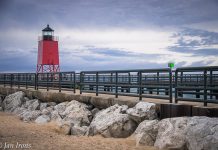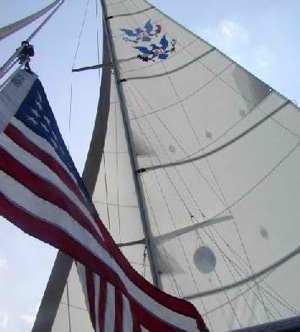After our sails down the west coast of Florida, all against the wind and current, we agreed we’re going to turn into “real cruisers” and not sail into the wind. i.e. if the wind is coming from the direction we want to sail, we wait until the wind is right — preferable 10-12 knots on our stern quarter.
So we’ve been in Marathon for 5 days waiting for a weather window to the Bahamas. Some boats have been waiting for months – the first good window was last weekend. Alot of boats have already given up and headed home. Since we’re not on the east coast of Florida, so we have to get from Marathon further east before jumping out into the gulf stream. 140 degrees, southeast, would be perfect wind for our first leg from Marathon to Rodriguez Key a 47 miles run due east … that’s 90 degrees.

The forecast window is looking almost perfect, SE 10-14. Except right now (9 PM Thursday night) the actual wind out at the Sombrero Reef Light NOAA weather buoy is 90 degrees at 14 gusting to 16 –NOT in the forecast. Directly on the nose, our course will be 70-90 degrees. Keeping our fingers crossed the wind actually behaves by morning and allows us to get to Rodriguez -don’t forget, our little 30 hp putt-putt diesel cannot motor into winds over about 10 knots so 10-15 is marginal. The good news is that it would be inside the Keys reef, so the seas should be less.
But WAIT! Last time we did this (just last Friday) we agreed we were going to grow up to be “real cruisers” from now on and go the way the wind blows us. Which in this case might be Key West or the Dry Tortugas, but certainly not anywhere EAST! 🙂 Crap. I guess we’ll just wait and see what the morning brings!
If we do end up motorsailing east, we have a few tricks that seem to make the boat stay closer to the wind and make the ride easier …

1. Sheet the main in as tight as we can possible pull it – centerline it on the boat.
2. After the main is in as tight as possible, we pull the traveler to windward — pretty close to all the way. This allows the main to capture more close-hauled air than a main at centerline.
3. If the jib won’t hold, which likely it won’t — it’ll be busy flailing and flopping. We’ll roll it in until it’s a scrap and then center it on the boat as well so it acts to keep us from rocking and rolling, but doesn’t really add much boat speed. As the wind goes further off dead on the nose, we’ll release more and more jib, but continue to sheet it in close.
4. Then set the windvane if there’s enough wind (you’d be surprised how often the Monitor windvane will work even motorsailing as close to the wind as possible — and it has the advantage if the wind lets you go up for even a minute, the windvane takes advantage of it — much better than we can), and if there’s not enough wind, set the autopilot and go. Sometimes we’ll have to short tack several times to get close to our destination. Then we’ll take the sails down and motor into the wind/waves the final mile or so to the channel. That’s what we did with our sail from Indian Key to Marathon — for more info on that sail, click here.

One other recommendation…. we’ve all heard it all before, but DO NOT ENTER after dark. With the current against us we arrived at the buoy outside the 7 Mile Bridge at Marathon about 9 PM, just after sunset and the light faded, leaving pitch black. Looking toward the bridge was disorienting with all the lights of the traffic on the bridge, the red lights on all the towers in the distance and the navigational lights. We decided to continue because we had two safe tracks in on our GPS – tracks that we had used before in broad daylight. But it was VERY scary. Not recommended. We don’t intend to try it again, especially when we cross onto the Bahamas Banks it needs to be LIGHT! We haven’t been there before and the ocean goes from thousands of feet deep to 10-15 feet in a matter of seconds. NOT something to trifle with on our first crossing. So we have to either sail all night to arrive at daybreak OR leave in the middle of the night to time the arrival in the mid-morning light. We still haven’t made the final decision.
By the time you read this, hopefully it’ll be daylight Saturday and we’ll be crossing onto the Bahama Banks enroute to the Exumas… or we might decide to become the “real cruisers” we agreed to be and end up in Key West … I hope not, we’ve been there and I love it, but I want to go play in the Exumas for awhile!

Anyone out there have better pinching as close as possible to wind on the nose techniques? Please share Leave a comment and let us know what we could do to motorsail closer to the wind! I’m sure wind on the nose will happen again, it seems to plague our cruising! 🙂













